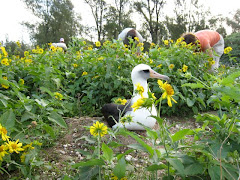
Day 1
Discovering Po.
As sun broke we were able to have our first opportunity to see what lay before us in the land of Po. We were “handed our bikes and freedom” and so began our journey with Pihemanu and the opportunity to explore all that was presented before us. We all set off from the same place, but dispersed in different directions, paths crossing along the way.
Myself, Sarah & Jen cycled to the affectionately named “Bulky Dump” and left our bikes to weave around the nesting fledglings who reminded us of their stand on the island with powerful “claps” of their beaks. Here, on Midway nature has the right of way!
At the end of the spit there were beautiful vistas onto light turquoise water that progressively darkened as the reefs shelved away into the lagoon. You could see Hawaiian Monk seals in the distance and Red Tailed Tropic birds flying above with the soaring albatross. The image is one as you might of a small Atoll in the middle of the Pacific Ocean – simply and overwhelmingly beautiful.
At the end of the spit there was a dead chick – I peeled back the feathers with a stick and the rib cage to find a carcass full of plastic – some large fishing floats and bottle lids. Nature’s genius creations of feathers and bones to protect was no protection for manmade materials. The impact of discovering this is so much more than seeing the photos – although hard to believe. Where did that bottle lid come from? Did the user ever realize it’s fate to our seas and oceans?
Do we ever stop in our daily lives and consider the journey of our latest toys, paintbrush, lighters or food packaging? The materials used to make it - the fuel needed for transportation and its eventual fate.
If one day we were all to consider the journey from the beginning of all the components of our purchases to their eventual fates and all the consequences in between – would we behave differently? We are in an era of convenience but convenience does not equate to better for us now or in the future. Life in all its forms takes time, care, and consideration to create fulfillment, health & happiness for the present and for our future and the legacy we leave behind us.
Sometimes we need to face the harsh realities of what we do to nature. The act of peeling away the feathers and breaking the rib cage and lifting the sternum – is like peeling away your consciousness. The contrast between this and the beauty of Midway does nothing but inspire and motivate change.
Consider this – in Johnstone Museum on the mainland we saw the beautiful cloak aha’ula – feathered cape of King Kamehamaha’s wife – originally. Sadly, after visiting England the King and his wife both died from measles and so the cloak was passed to his daughter. This large cloak showed the finest workmanship and was made from beautiful small golden yellow feathers from the “mamo” bird which covered the cloak. The bird catchers or “kia manu” would collect the feathers which there were only a few of on the wing and tail of each bird. The way this was done was to cover the branch with sticky sap and then once the bird landed they would carefully remove the molting feathers – clean the birds’ feet and return them to the cleaned tree. The work involved in this process alone showed how much time and care went into the making of that cloak. How happy the King’s daughter must have felt to wear such a beautiful cloak and proud the people who helped in its creation.
Do we feel the same way when we buy something that has had a questionable past and an uncertain future?
That is the magic of Pihemanu – the opportunity to let nature teach you, to consider our lives and journeys that will be influenced by Pihemanu but ultimately to think! While doing this we are so amazingly fortunate to be surrounded by the beautiful majestic creatures all around us – Albatross, Hawaiian Monk Seal, Fairy Tern and of course – all the people.

















thank you, Maya :)
ReplyDelete